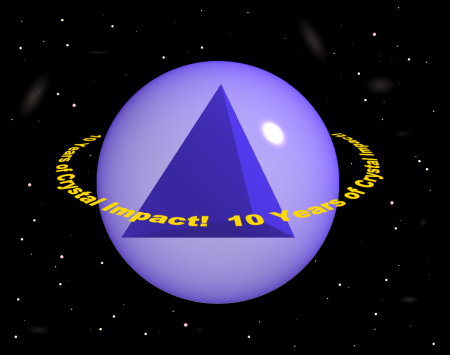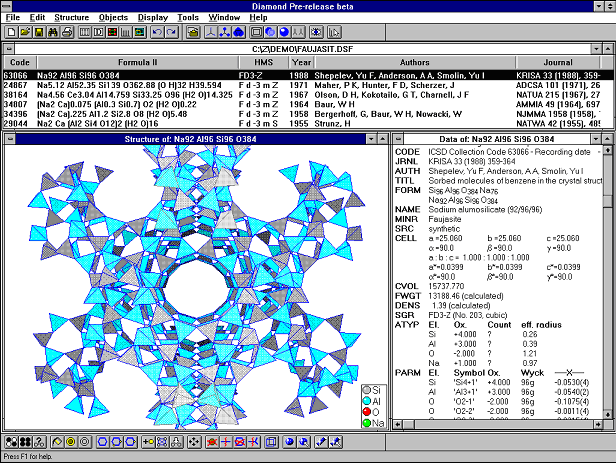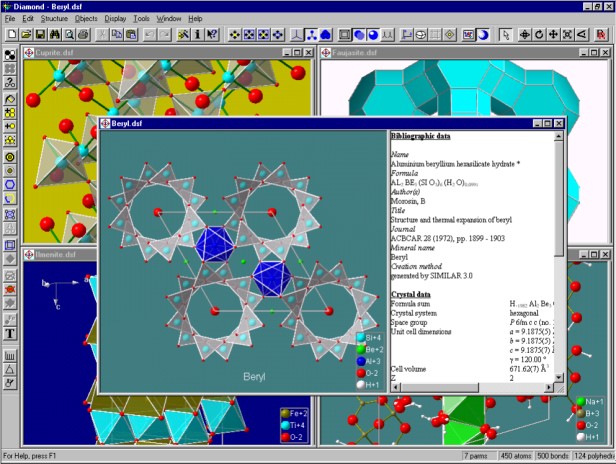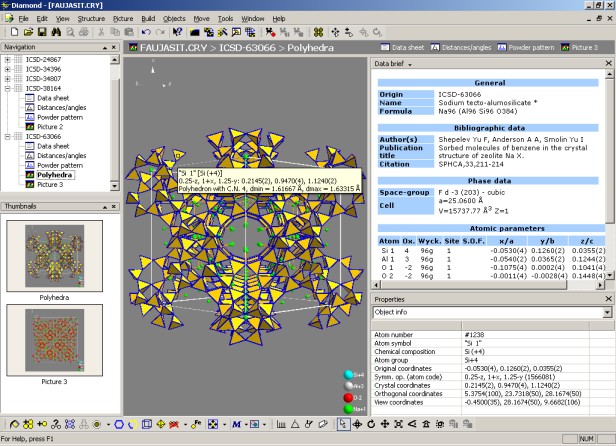10 Years of Crystal Impact

In 2007, Crystal Impact celebrated its 10th anniversary. Please read what happened
since the foundation of Crystal Impact in 1997.
Foundation
Crystal Impact was founded on November 1, 1997 by Dr. Michael Berndt and Dr. Klaus
Brandenburg as a successor of the "Prof. Dr. G. Bergerhoff Software-Entwicklung". By that
time, the first version of Diamond was already available (since July 1995),
looking like this:

First Product
About half a year after the foundation of Crystal Impact, in June 1998 version 2
of Diamond was released, and Michael and Klaus presented it on the ECM-18 in Prague
in August 1998. The key feature of this new
version was the shaded representation of atoms, bonds, etc., making use of the
OpenGL 3D graphics library. The screenshot below shows a composition of different kinds of
structures showing the new capabilities of version 2, such as
transparency, space-filling with correct overlap, shaded ellipsoids etc.

Move
The Crystal Impact office in the early years was still located at the University of Bonn.
However, the original room became too small for a professional working company. As a result,
Crystal Impact moved to a new large office "just around the corner" in the
Immenburgstr. 20 in Bonn, Germany at the end/beginning of 1999/2000.
Second Product
On November 15, 2000, Crystal Impact released a new innovative product called "Endeavour".
The focus of this software was the solution of crystal structures from powder diffraction
data. From a technical point of view, the software resulted from merging Diamond and
a program called "Diff42" developed by Dr. Holger Putz which performed the actual calculations (the "Endeavour kernel"). Very early versions had already been presented
on DGK meeting Leipzig (March 1999) and IUCr meeting Glasgow (August 1999) by Holger
and Michael.
New Partner
On January 1, 2001, Dr. Holger Putz was admitted as a new partner.
New Product
A new product was announced since 2000 and launched in April 2002: "Pauling File,
Binaries Edition". (The Pauling File project was already launched in 1995 by Pierre Villars et. al. with the aim to create tools for
scientists working with inorganic compounds, with particular focus on materials
design. As a first step, a comprehensive, phase-oriented database was being built up.) This
innovative product merged crystal structure data of non-organic compounds (no C-H bonds) with phase diagrams,
diffraction data, and physical property data. Though the project covers
all binary, ternary and multinary, non-organic
compounds (no C---H bonds), the first edition was limited to binary compounds (http://dx.doi.org/10.1016/j.jallcom.2003.08.058).
Unfortunately, the producing company Material Phases Data System (MPDS,
P. Villars) had to interrupt further development of this extremely promising and ambitious product due to funding problems. The Binaries Edition is available at
ASM International.
Sad News
Dr. Michael Berndt, one of the three Crystal Impact partners, died on June 30th, 2003 after a long, serious illness
at the age of 39. Obituary...
New Product
On September 22, 2003, "Match!", a new software for phase identification from powder diffraction data,
was released. Being initially designed as a low-price alternative to existing solutions,
the program quickly showed its separative power, with customers reporting the identification
of previously unknown phases and mixtures.
New Version of Diamond
Crystal Impact's engagement in software development for Pauling File in the
years 2000 through 2002 and
Michael's death on June 30, 2003, caused multiple delays in the
development of the next major version 3, which was finally released on
October 15, 2004. Amongst several new features like POV-Ray graphics
export, powder pattern simulation, this new version can process more than one
structure parameter set in a document (file) as well as multiple pictures for a
structure parameter set each, as you can see from the screenshot below.

New Crystal Structure Database
On February 22, 2007, Crystal Impact announced the distribution of a new crystal structure database
for inorganic compounds, Pearson's Crystal Data, published by
ASM International.
The database comes with an innovative and thought-out Windows user interface developed by
Crystal Impact.
Move #2
After almost eight years in the Immenburgstra�e Crystal Impact moved to a new office
in November 2007. The new address is: Rathausgasse 30, D-53111 Bonn.
Current Status
Today, Crystal Impact is a well-known developer of crystallographic
and related software products, with appr. 600 institution customers in 54 countries all around the world. Crystal Impact currently offers three different own products
(Diamond, Endeavour,
and Match!) and one crystallographic database
(Pearson's Crystal Data).
Outlook
The software developers at Crystal Impact definitely have not stopped thinking about new innovative software products in the area of
crystallography and powder diffraction. The next round of major updates for all three
own products Match! 2, Endeavour 2,
and Diamond 4 is planned for 2009. And there are still some dreams about really
modern crystallographic database programs which are impatiently waiting to be realized...
|

